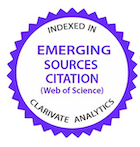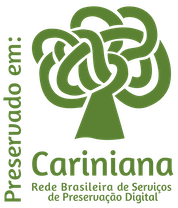Estudo clínico e anatomopatológico da urolitíase em cordeiros confinados submetidos à dieta com diferentes concentrações de fósforo
DOI:
https://doi.org/10.1590/1809-6891v22e-67849Resumo
A urolitíase obstrutiva é frequente na ovinocultura e possui etiologia multifatorial, porém o manejo nutricional inadequado é considerado o mais relevante para sua ocorrência. Os objetivos deste estudo foram verificar a influência de duas dietas com diferentes proporções e concentrações de cálcio (Ca) e fósforo (P) no desenvolvimento da urolitíase obstrutiva, e descrever os achados clínicos e anatomopatológicos do sistema urinário de ovinos. Utilizaram-se 30 cordeiros, machos, mestiços das raças Santa Inês e Ile de France, que foram aleatoriamente distribuídos em dois grupos: Grupo 1 (G1, n=15) – Ca:P de 1,9:1 e 0,42% de P; Grupo 2 (G2, n=15) – Ca:P de 1,5:1 e 0,65% de P. As dietas foram fornecidas por 90 dias consecutivos com feno de Coast-cross, farelo de soja, trigo e milho, e água ad libitum. Após o diagnóstico da doença, os cordeiros foram submetidos ao tratamento clínico e cirúrgico, quando necessário. A urolitíase foi detectada em 36,7% (11/30) dos cordeiros, sendo 26,7% assintomáticos e 10% (3/30) apresentaram obstrução uretral. Um cordeiro foi desobstruído após amputação do processo uretral e sondagem uretral; outro foi a óbito por ruptura vesical e uroperitôneo; outro foi sacrificado após uretrostomia perineal e cistostomia sem sucesso. Em ambos os grupos, as alterações histopatológicas renais mais frequentes foram congestão vascular, dilatação e degeneração tubular. A presença de proteínas na luz tubular foi mais pronunciada no G2. As dietas fornecidas, ricas em concentrado, embora com relação Ca:P adequadas, provocaram a calculogênese, o que comprovou que o excesso de minerais e pouca quantidade de volumoso podem causar a enfermidade no rebanho.
Palavras-chave: cálculo, confinamento, fósforo, obstrução uretral, ovinos.
Downloads
Referências
Guimarães JA, Mendonça CL, Sousa Guaraná EL, Dantas AC, Azevêdo CN, Câmara ACL, Farias CC, Afonso JAB. Estudo retrospectivo de 66 casos de urolitíase obstrutiva em ovinos. Pesquisa Veterinária Brasileira. 2012; 32(9), 824-830. doi: 10.1590/S0100-736X2012000900002
Maciel TA, Ramos IA, Silva RJ, Soares PC, Carvalho CCD, Maior Júnior RJS, Amoroso L, Artoni SMB, Afonso JAB, Oliveira, D. Clinical and Biochemical Profile of Obstructive Urolithiasis in Sheep. Acta Scientiae Veterinariae. 2017; 45, 1-15. Available from: https://www.redalyc.org/articulo.oa?id=289053641089.
Riet-Côrrea F, Simões SVD, Vasconcelos JS. Urolitíase em caprinos e ovinos. Pesquisa Veterinária Brasileira. 2008; 28(6), 319-322.
Antonelli AC, Barrêto Júnior RA, Mori CS, Sucupira MCA, Marcello ACS, Ortolani EL. Efeito de diferentes fontes energéticas na predisposição para urolitíase em cabritos. Ciência Animal Brasileira. 2012; 13, 487-493. doi: 10.5216/cab.v13i4.15617
Ferreira DOL, Santarosa BP, Amorim RM, Chiacchio SB, Gonçalves RC. (2015). Urolitíase obstrutiva em ovinos. Veterinária e Zootecnia. 2015; 22(2), 183-197.
Ewoldt JM, Jones ML, Miesner MD. Surgery of obstructive urolithiasis in ruminants. Veterinary Clinics of North America: Food Animal Practice. 2008; 24, 455-465. doi: 10.1016/j.cvfa.2008.06.003
Kinsley MA, Semevolos S, Parker JE, Duesterdieck-Zellmer K, Huber M. Use of plain radiography in the diagnosis, surgical management, and postoperative treatment of obstructive urolithiasis in 25 goats and 2 sheep. Veterinary Surgery. 2013; 42, 663-668. doi: 10.1111/j.1532-950X.2013.12021.
Van Metre D, Fecteau G, House JK. Obstructive urolithiasis in ruminants: surgical management and prevention. Compendium on Continuing Education for the Practicing Veterinarian. 1996; 19: 275-289.
Dória RGS, Canola PA, Dias DPM, Pereira RN, Valadão CAA. Surgical Techniques for obstructive urolithiasis in small ruminants: case report. Arquivo Brasileiro de Medicina Veterinária e Zootecnia. 2007; 59(6), 1425-1432. doi:10.1590/S0102-09352007000600012
Freeman SR, Poorea MH, Young GA, Anderson KL. Influence of calcium (0.6 or 1.2%) and phosphorus (0.3 or 0.6%) content and ratio on the formation of urolithogenic compounds in the urine of Boer-cross goats fed high-concentrate diets. Small Ruminant Research. 2010; 93, 94-102. doi: 10.1016/j.smallrumres.2010.05.007
Streeter RN, Washburn KE, Mccauley CT. Percutaneous tube cystostomy and vesicular irrigation for treatment of obstructive urolithiasis in a goat. Jornal of the American Veterinary Medical Association. 2002; 221, 546-549. doi: 10.2460/javma.2002.221.546
Sun WD, Zhang KC, Wang JY, Wang XL. The chemical composition and ultrastructure of uroliths in Boer goats. The Veterinary Journal. 2010; 86, 70-75. doi: 10.1016/j.tvjl.2009.07.009
Aquino Neto HM, Facury Filho EJ, Carvalho AU, Souza FA, Jordão LR. Urolitíase obstrutiva em ovinos: revisão de literatura. Veterinária em Foco. 2007; 4(2), 191-202.
Ferreira DOL, Santarosa BP, Sacco SR, Dias A, Amorim RM, Chiacchio SB, Lis¬bôa JAN, Gonçalves RC. Efeito da suplemen¬tação de cloreto de amônio sobre o equilíbrio ácido-básico e o pH urinário de ovinos confinados. Pesquisa Veterinária Brasileira. 2014a; 34(8), 797-804. doi: 10.1590/S0100-736X2014000800016
Maciel TA, Júnior NL, Araújo VV, Silva Filho AB, Gomes DLS, Barbosa AMS, Farias CC, Magalhães ALR, Lima MJM, Melo SAX, Oliveira D. Avaliação dos perfis minerais séricos, urinários e sedimentares de ovinos recebendo dieta calculogênica. Arquivo Brasileiro de Medicina Veterinária e Zootecnia. 2016; 68(4), 967-976. doi: 10.1590/1678-4162-8363
National Research Council - NRC. Nutrient Requirements of Small Ruminants: sheep, goats, cervids and New World camelids. Natl Acad. Press, Washington, DC. 2007, 384p.
Russel A. Body condition scoring of sheep. In: E. Boden (Ed.) Sheep and Goat Practice. Bailliere Tindall, Philadelphia. 1991. p3.
Scott PR, Sargison ND. Ultrasonography as an adjunct to clinical examination in sheep. Small Ruminant Research. 2010;92, 108–119. doi: 10.1016/j.smallrumres.2010.04.011
Scott P. Transabdominal Ultrasonographic Examination of 26 Sheep with Suspected Urinary Tract Disease (2010- 2012 Journal of Veterinary Science & Medical Diagnosis. 2013; 2, 1-5. doi: 10.4172/2325-9590.1000107
Ferreira DOL, Santarosa BP, Belotta AF, Mamprim MJ, Silva AA, Dias A, Chiacchio SB, Gonçalves RC. Alterações ultrassonográficas renais e vesicais de ovinos confinados e suplementados com cloreto de amônio. Pesquisa Veterinária Brasileira. 2014b; 34(supl1), 99-106. doi:10.1590/S0100-736X2014001300018
Santarosa BP, Ferreira DOL, Rodrigues MMP, Dantas GN, Sacco SR, Lopes RS, Dias A, Gonçalves RC. Clinical, laboratory and anatomopathological evaluation of the urinary system of feedlot sheep with or without ammonium chloride supplementation. Pesquisa Veterinária Brasileira. 2016; 36(1), 1-12. doi: /10.1590/S0100-736X2016000100001
Oman RE, Reppert EJ, Jones SM. Outcome and complications in goats treated by perineal urethrostomy for obstructive urolithiasis: 25 cases (2010-2017). Journal of Veterinary Internal Medicine. 2019; 33, 292- 296. doi: 10.1111/jvim.15360
Guedes Jr FS, Cruz DS, Rodrigues MMP, Silva LM, Amorim RL, Vianna PTG, Castiglia YM M. Renal histology and immunohistochemistry after acute hemorrhage in rats under sevoflurane and ketoprofen effect. Acta Cirurgica Brasileira. 2012; 27(1), 37-42. doi: 10.1590/S0102-86502012000100007
Van Metre DC, Fubini SL. Ovine and caprine urolithiasis: Another piece of the puzzle veterinary surgery. Veterinary Surgery. 2006; 35, 413-416. doi: 10.1111/j.1532-950X.2006.00168.
Santarosa BP, Ferreira DOL, Belotta AF, Dias A, Mamprim MJ, Gonçalves RC. B-Mode and pulsed Doppler sonography of kidney in healthy sheep according to age. Pesquisa Veterinária Brasileira. 2016; 36(6), 545-550. doi: 10.1590/S0100-736X2016000600014
Unanian MM, Rosa JSR, Silva EDF. Urolitíase Experimental Em Caprinos: Possíveis Causas E Profilaxia. Pesquisa Agropecuária brasileira. 1985; 20(4), 467-474.
Samal L, Pattanaik AK, Mishra C, Maharana BR, Sarangi LN, Baithalu RK. Nutritional strategies to prevent urolithiasis in animals. Veterinary World. 2011; 4(3), 142-144.
Riedi AK, Knubben-Schweizer G, Meylan M (2018) Clinical findings and diagnostic procedures in 270 small ruminants with obstructive urolithiasis. Journal of Veterinary Internal Medicine. 2018; 32: 1274–1282. doi: 10.1111/jvim.15128
Halland S, Phelps M, House JK. New methods to treat and prevent obstructive urolithiasis in small ruminants and pot-bellied pigs. In: Proceedings of the 18o American College of Veterinary Medicine Forum; Lafayette, Colorado. Lafayette: American College of Veterinary Medicine Forum. 2000; 268-270.
Fortier LA, Gregg AJ, Fubini SL. Caprine obstructive urolithiasis Requirement for 2nd surgical intervention and mortality after percutaneous tube cystotomy, surgical tube cystotomy, or urinary bladder marsupialization. Veterinary Surgery. 2004; 33(6), 661-667. doi: 10.1111/j.1532-950X.2004.04089
Haven ML, Bowman KF, Englebert TA, Blikslager AT. Surgical management of urolithiasis in small ruminants. Cornell Veterinary. 1993; 83(1), 47–55.
Janke JJ, Osterstock JB, Washburn KE, Bissett WT, Roussel Jr AJ, Hooper RN. Use of Walpole’s solution for treatment of goats with urolithiasis: 25 cases (2001–2006). Journal of the American Veterinary Medical Association. 2009; 53, 234- 249. doi: 10.2460/javma.234.2.249
Riedi AK, Christina N, Gabriela KS, Karl N, Mireille. M. Variables of initial examination and clinical management associated with survival in small ruminants with obstructive urolithiasis Journal of Veterinary Internal Medicine. 2018; 32, 2105- 2114. doi: 10.1111/jvim.15336
Fazili MR, Malik HU, Bhattacharyya HK, Buchoo BA, Moulvi BA, Makhdoomi DM. Minimally invasive surgical tube cystotomy for treating obstructive urolithiasis in small ruminants with an intact urinary bladder. Veterinary Record. 2010; 166, 528-532. doi:10.1136/vr.b4831
Pearce SG, Dearo AC, Howard BE, Brisson BA. Management of obstructive urolithiasis and concurrent urethral rupture in a goat. Australian Veterinary Journal. 2003; 81, 268-270. doi: 10.1111/j.1751-0813.2003.tb12568
Chigerwe M, Heller MC, Balcomb CC, Angelos JA. Use of a percutaneous transabdominal catheter for management of obstructive urolithiasis in goats, sheep, and potbellied pigs: 69 cases (2000–2014). Jornal of the American Veterinary Medical Association. 2016; 248(11), 1287-1290. doi: 10.2460/javma.248.11.1287
Davoodi F, Zakian A, Raisi A, Rocky A, FarjaniKish G. Report of urinary bladder rupture following obstructive urolithiasis in rams of Romanov sheep flock. Comparative Clinical Pathology. 2020; 29, 1277-1282. doi: 10.1007/s00580-020-03165-1.
Alimi OA, Bello M, Baraya YS, Raji A, Bashir S, Bello AA, Shoyinka SVO. Obstructive Urolithiasis In Ouda-Yankasa Ram: Case Report. Animal Research International. 2018; 15(2), 2989-2993. doi:10.4314/as.v17i1.7
Frelier PF, Armstrong DL, Pritchard, J. Ovine mesangiocapillary glomerulonephritis type I and crescent formation. Veterinary Pathology. 1990; 27, 26-34. doi: 10.1177/030098589002700104
Downloads
Publicado
Como Citar
Edição
Seção
Licença
Copyright (c) 2021 Ciência Animal Brasileira

Este trabalho está licenciado sob uma licença Creative Commons Attribution 4.0 International License.
Autores que publicam nesta revista concordam com os seguintes termos:
- Autores mantém os direitos autorais e concedem à revista o direito de primeira publicação, com o trabalho simultaneamente licenciado sob a Licença Creative Commons Attribution que permite o compartilhamento do trabalho com reconhecimento da autoria e publicação inicial nesta revista.
- Autores têm autorização para assumir contratos adicionais separadamente, para distribuição não-exclusiva da versão do trabalho publicada nesta revista (ex.: publicar em repositório institucional ou como capítulo de livro), com reconhecimento de autoria e publicação inicial nesta revista.
- Autores têm permissão e são estimulados a publicar e distribuir seu trabalho online (ex.: em repositórios institucionais ou na sua página pessoal) a qualquer ponto antes ou durante o processo editorial, já que isso pode gerar alterações produtivas, bem como aumentar o impacto e a citação do trabalho publicado (Veja O Efeito do Acesso Livre).






























